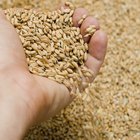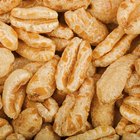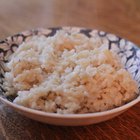
Pizza dough is an unusually specialized form of flatbread. Like ordinary yeast-raised bread it relies on gluten to trap the yeast's leavening gases, but if the gluten is too strong your crust can be difficult to stretch properly. That need for relatively weak gluten makes pizza dough a good candidate for experimenting with alternative flours. You can readily improve the crust's flavor and nutrition, or even make it completely gluten-free.
Finding Wholeness
The most mainstream alternatives to conventional white all-purpose flour are whole wheat and white whole wheat. When white flour is milled, the high-fiber bran and nutrient-rich germ are removed. That's partly for appearance -- they make the flour brown -- and partly because the bran and germ contain most of the wheat's natural oils, which can become rancid in storage. Whole wheat flours keep best if they're refrigerated between uses, to slow that deterioration. Making your pizza crust with regular whole wheat or white whole wheat adds fiber and nutrients, especially B vitamins. White whole wheat flour is made with "white" wheat, which has paler bran than the more common red wheat. It's usually milled more finely, so it resembles white flour.
Kissin' Cousins
Pizza dough can also accommodate a number of grains that are close cousins to mainstream wheat. Durum wheat is often added to pizza dough in the form of durum flour, or coarse semolina, because if its rich, nutty flavor. Durum is an ancestral form of true wheat, cultivated for thousands of years but now mostly used in pasta. Spelt is another ancient wheat, available in "white" and whole-grain versions that work well in pizza and other yeast-raised doughs. Kamut produces much larger kernels but is similar to wheat and spelt for culinary purposes, giving your crust a rich, creamy color and nutty flavor.
Going Further Afield
Although they bring some variety to your dough, whole-grain wheats and wheat-like grains aren't the only game in town. Even a small amount of rye flour gives the crust a richer flavor, and its stretchier gluten is ideal for pizza. Oat flour or barley flour adds sweetness, rice flour and corn flour make the crust crisp, and corn flour also adds an appealingly sunny color. Millet and teff flour give the pizza a richly nutty flavor, and so do pseudograins such as buckwheat, amaranth and quinoa. Small quantities of bean or chickpea flour make the dough dense, but sharply increase its nutritive value.
Going Gluten-Free
Many of these grains and pseudograins are suitable for celiacs and those with wheat allergies. Rice, corn, millet, teff, buckwheat, amaranth and quinoa are all naturally free of gluten. So are oats and barley, but they're more problematic because they're often milled in plants that also work with wheat flour. Look for brands that are produced in certified gluten-free facilities. Any gluten-free flours, alone or in combination, can make a serviceable cracker-style flatbread. For a risen dough more like conventional pizza, add ingredients such as xanthan gum or simply use a prepared gluten-free baking mixture.
Related Articles

What Additives Are in Flour?

Difference Between Red & White Wheat

How to Make Bread Flour
Is Unbleached Flour the Same as ...

How to Cook With Kamut

What Is White Oat?

Does Flour Get Old or Go Bad?

Is Jasmine Rice Naturally White or Is ...

What Kind of Bread Do I Serve With ...

Whole Wheat Pastry: Flour Substitutions

How to Replace Wheat

Psyllium Husk & Gluten

Calories in Gluten Free Pasta

How Long Do I Cook Vermicelli?

Substitute for Gram or Besan Flour

Can You Substitute Whole Wheat Pastry ...

How to Make Pumpernickel Flour

What Is Amaranth Flour?

Bulgar Wheat Vs. Couscous

How to Cook Brown Basmati Rice
References
- On Food and Cooking: The Science and Lore of the Kitchen; Harold McGee
- Serious Eats: Alternative Flours -- All About White Whole Wheat, Spelt, Rye and More
- The Cook's Thesaurus: Wheat Flours
- The Cook's Thesaurus: Non-Wheat Flours
Writer Bio
Fred Decker is a trained chef and prolific freelance writer. In previous careers, he sold insurance and mutual funds, and was a longtime retailer. He was educated at Memorial University of Newfoundland and the Northern Alberta Institute of Technology. His articles have appeared on numerous home and garden sites including GoneOutdoors, TheNest and eHow.
Photo Credits
Spike Mafford/Photodisc/Getty Images